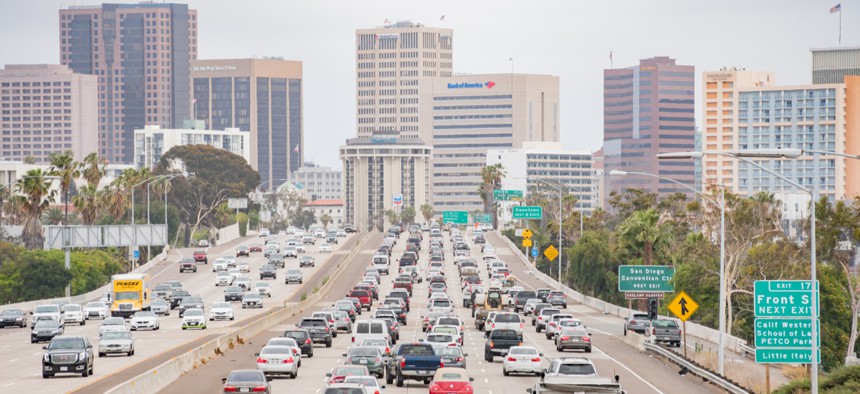Trump Administration Takes First Step in Weakening Fuel Economy Standards

If finalized, the EPA proposal would also revoke California’s ability to set its own goals used by 13 other states and ignite a fresh legal battle.
The Environmental Protection Agency issued a draft proposal Thursday that would lock fuel economy and tailpipe emissions standards beginning in model year 2020 and halt implementation of stiffer requirements for cars and trucks put in place by the Obama administration.
On April 2, EPA determined the 2022 to 2025 standards set by the agency in 2012 were unattainable, a finding California is challenging in court. The new standards the EPA’s plan sets would last through 2026.
California’s Clean Air Act waiver—which saw the state set a more aggressive target of 50 miles per gallon by 2025, a move subsequently adopted by another 13 states—would be revoked under the Trump administration proposal. EPA argues California is “attempting to solve climate change” rather than “addressing smog-related air quality problems,” which runs counter to the waiver’s original purpose.
“Our proposal aims to strike the right regulatory balance based on the most recent information and create a 50-state solution that will enable more Americans to afford newer, safer vehicles that pollute less,” said Andrew Wheeler, EPA acting administrator, in a statement. “More realistic standards can save lives while continuing to improve the environment.”
Under current standards, vehicle costs have risen to $35,000 on average, an increase of $2,340 since 2012, in addition to $500 billion in “societal costs” to the U.S. economy, according to the proposal. Those losses include technological, traffic fatality, congestion and noise costs.
The “next generation” Safer Affordable Fuel-Efficient, or SAFE, Vehicles Rule will “correct” Corporate Average Fuel Economy standards to 37 miles per gallon and save about 1,000 lives annually compared to the Obama-era goals, according to the proposal. Drivers will be less inclined to buy vehicles when they have to pay more for gas at the pump, meaning fewer people will be on the road and there will be fewer traffic fatalities, Wheeler testified before the Senate Environment and Public Works Committee on Wednesday.
Critics lambasted the Trump administration’s analysis.
“At first glance, this proposal completely misrepresents costs and savings. It also relies on bizarre assumptions about consumer behavior to make its case on safety,” said Mary Nichols, chair of the California Air Resources Board, in a statement. “CARB will examine all 978 pages of fine print to figure out how the administration can possibly justify its absurd conclusion that weakening standards to allow dirtier, less efficient vehicles will actually save lives and money.”
Car and truck carbon dioxide emissions are responsible for thousands of deaths per year in the U.S., and that pollution needs to decrease 10 percent annually across the developed world to even get close to the Paris Agreement’s maximum 2 degree increase in global temperatures, said Neil Donahue, Carnegie Mellon University chemical engineering professor, in a statement.
Freezing standards would cost the U.S. economy $457 billion by 2050 because early savings building cheaper, less efficient cars would be outweighed by increased fuel expenses year over year, according to Energy Innovation: Policy and Technology LLC research. But, should California win its court case against EPA, only 65 percent of the vehicle market would be affected by Trump policy—lessening the blow to $274 billion.
California Attorney General Xavier Becerra took to Twitter to reaffirm his office’s commitment to fighting EPA’s proposed standards in court.
Gas prices increased 26 percent in the last year, so reducing oil dependence will not only keep money in American families’ pockets but also create jobs building clean vehicles, said Shannon Heyck-Williams, National Wildlife Federation senior manager for climate and energy, in a statement.
At least 650,000 jobs, 26 percent of the motor vehicles sector, are focused on improving fuel economy and clean fuels, according to a May 2018 National Association of State Energy Officials report.
Environmental Entrepreneurs, or E2—a nonpartisan group of industry experts and business leaders, who support clean car standards among other environmentally friendly policies—plans to send a letter signed by its members to administration officials urging them to withdraw their proposal.
“There is simply no basis for the claim that encouraging U.S. automakers to innovate and compete globally hurts consumers,” said Grant Carlisle, E2 director of advocacy, in a statement.
Others celebrated the Trump administration’s proposal, saying that when buying a vehicle, consumers must confront immediate costs before thinking about future gas prices.
"It's essential to have realistic CAFE goals that don't force American families to choose between putting food on the table and having a modern vehicle," said Horace Cooper, co-chairman of the Project 21 conservative black leadership network, in a statement. "The Trump proposal will help put consumers back in the driver's seat by giving them the ability to select a household vehicle based on their actual needs rather than the utopian ideals of radicals."
Though locking fuel economy standards is the “preferred alternative” to the Obama-era rule, according to the proposal, Wheeler earlier this week told senators EPA was open to a compromise reached by the automotive industry, California and the 13 other states piggybacking on its waiver.
The auto industry has indicated it’s open to improving fuel economy with advanced technologies—if only California and the federal government can come to terms. The Alliance of Automobile Manufacturers issued a statement Thursday saying “it’s time for substantive negotiations to begin.”
Attorneys with the Natural Resources Defense Council said the advocacy group is prepared to challenge the SAFE Vehicles Rule in court, if finalized, and they’re confident they will win.
“When the Trump administration’s initial proposal is to say, ‘We’re going to kneecap you,” it’s hard to go back and say, ‘Let’s talk,’” said Simon Mui, a senior scientist with the organization, on a Thursday afternoon press call.
There’s no precedent for withdrawing California’s waiver, and EPA bears the burden of proving California doesn’t deserve one even though the Obama-era standards can be met, said Ben Longstreth, NRDC Climate & Clean Energy Program senior attorney.
“It’s trying to undo a waiver that’s based on extremely well-grounded conclusions made and that the agency’s own technical analysis also supports,” Longstreth added.
A prolonged legal battle could generate a great deal of uncertainty for the auto industry about whether to stick with the Obama rule as a baseline or shift to Trump’s new standards, Mui said.
EPA will accept public comments on its proposal, published on the Federal Register, for 60 days.
Dave Nyczepir is a News Editor at Government Executive’s Route Fifty and is based in Washington, D.C.
NEXT STORY: Breathing In Wildfire Smoke Prompts Concerns Across the West






